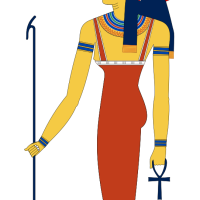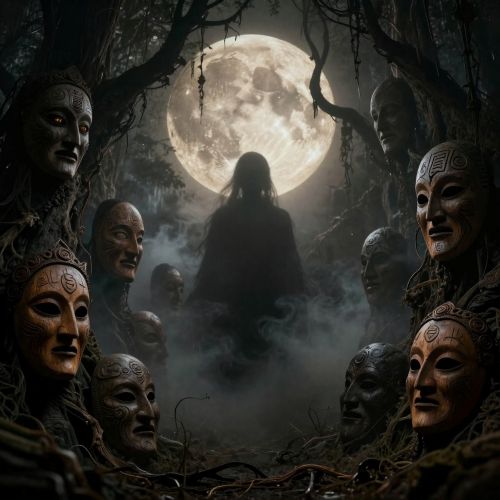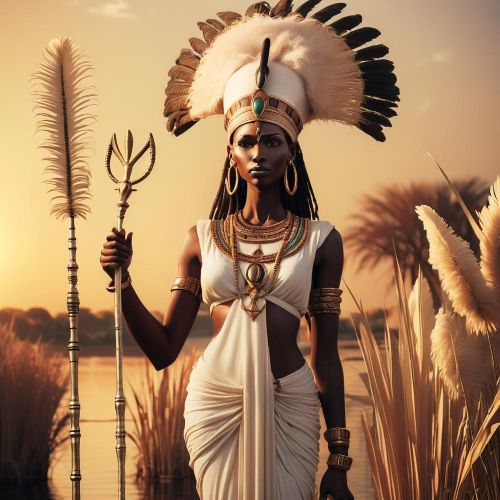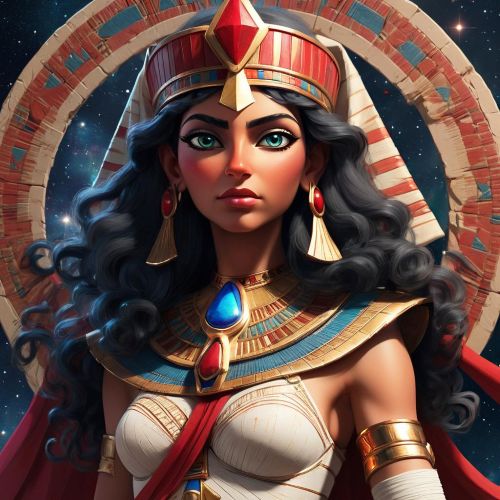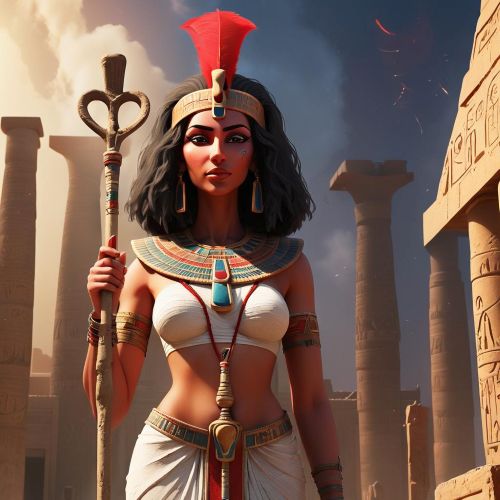Hemsut : Goddess of Fate
Listen
At a glance
| Description | |
|---|---|
| Origin | Egyptian Mythology |
| Classification | Gods |
| Family Members | N/A |
| Region | Egypt |
| Associated With | Fate, Protection |
Hemsut
Introduction
In Egyptian mythology, Hemsut (also spelled Hemuset or Hemusut) represents one of the most profound yet understated aspects of divine order—the embodiment of fate, protection, and the life force that governs existence. She personifies the shaping of destiny, ensuring harmony between mortal lives and the cosmic balance known as ma’at. Often described as the female counterpart to the masculine ka, Hemsut is a guardian of spiritual vitality and a mediator between divine will and human potential. Although she may not enjoy the same level of fame as Isis or Hathor, her role as the goddess of fate and protection gives her a lasting significance in Egyptian religious philosophy. Her essence bridges creation, destiny, and divine guardianship, making her a cornerstone of Egypt’s metaphysical worldview.
Physical Traits
In visual depictions, Hemsut is portrayed as a serene and regal woman crowned with a headdress featuring a shield crossed by two arrows. This symbol connects her to Neith, the ancient goddess of war and weaving, and also marks her association with the Sais nome (Sap-Meh) of Lower Egypt. The shield and arrows signify both protection and creative force—a duality that defines her nature as both nurturer and defender. In some temple carvings, she is seen kneeling and holding a child, a gesture symbolizing her guardianship over new life and her power to bestow vitality. She occasionally holds an ankh, the emblem of life, or a scepter, representing divine authority. These artistic details encapsulate her role as the goddess who guards destiny, nourishes the spirit, and sustains the cosmic equilibrium.
Family
The origins of Hemsut are fluid across Egypt’s theological traditions. In Memphite theology, she is said to have been created by Ptah, the divine craftsman and creator god who shaped the world through thought and speech. This connection emphasizes her role in divine craftsmanship and the construction of fate. In the Sais tradition, however, Hemsut is closely linked with Neith, who is believed to have drawn her from the primordial waters of Nun, the chaotic abyss that existed before creation. This lineage underscores her association with both creation and order, suggesting that fate itself was born from the act of divine creation. Ancient texts occasionally refer to multiple Hemsut, describing them as a collective of female deities who each governed an individual’s destiny, much like the Greek Moirai or the Norse Norns. This interpretation positions Hemsut not merely as a singular goddess but as the embodiment of the cosmic principle of destiny in many forms.
Other names
The name Hemsut derives from the Egyptian root ḥmswt, meaning “those who are seated” or “enthroned,” which symbolizes stability, authority, and the fixed nature of fate. Alternative spellings such as Hemuset and Hemusut arise from variations in hieroglyphic transliteration and dialectal differences across Egypt’s long dynastic timeline. In certain texts, particularly those from the Middle Kingdom, the term “Hemsut” could refer to spiritual personifications of fate rather than to one distinct goddess. This linguistic nuance highlights the Egyptians’ philosophical approach to divinity—where gods were not only beings but also principles of existence. The etymology of Hemsut’s name thus captures her role as both a divine entity and a universal constant, representing the enthroned power of destiny itself.
Powers and Abilities
The powers of Hemsut are deeply interwoven with the concept of the ka, the vital essence or spiritual double that animates all beings. As the female counterpart of this life force, Hemsut provides nourishment, protection, and creative energy. She was believed to be present at birth, shaping the destiny of each individual, determining their potential, talents, and fortune. Ancient Egyptians viewed her not as a force of predestination but as a divine guide, ensuring that one’s path aligned with the cosmic order.
In royal rituals, Hemsut was invoked to safeguard the pharaoh and the state, symbolically shielding them from chaos and misfortune. Texts from the Pyramid and Coffin Texts call upon her to guide the king’s destiny in the afterlife, ensuring safe passage through the Duat (the underworld). Her name appears in protective spells from the Book of the Dead, where she guards the deceased from malevolent forces and stabilizes their spiritual essence.
Hemsut’s powers extended to the realm of creation itself. During temple consecrations or the founding of cities, she was often invoked to bless the undertaking, imprinting divine purpose upon human endeavor. Her influence bridged mortal and divine intention, functioning as the energetic link between thought, creation, and destiny. Through her, the Egyptians expressed their belief that every act of creation—be it a life, a structure, or an idea—carried a destined purpose woven by divine will.
Modern Day Influence
Although worship of Hemsut faded with the decline of ancient Egyptian religion, her legacy continues to resonate in modern interpretations of mythology and spirituality. Scholars such as Dr. Emily Teeter and Dr. Geraldine Pinch have highlighted her importance as a representation of female creative energy and divine order, noting that she embodies the philosophical balance between free will and predetermination.
In popular culture, Hemsut occasionally appears in works that reinterpret Egyptian mythology for contemporary audiences. Novels like Rick Riordan’s The Kane Chronicles allude to deities governing destiny and protection, inspired by figures such as Hemsut. In video games such as Assassin’s Creed Origins, her symbols—like the crossed arrows and shield—feature prominently in designs that celebrate ancient Egyptian spirituality. These modern representations have revived interest in her as a guardian goddess of fate, blending mythological authenticity with creative reinterpretation.
In modern spiritual and neo-pagan movements, Hemsut is venerated as a protector and weaver of destiny. Practitioners use symbols such as the ankh and shield of Neith in rituals dedicated to manifestation, protection, and empowerment. Her archetype also appears in contemporary feminist theology, where she is seen as a divine embodiment of autonomous creation and feminine power.
Her continued cultural presence, both academic and esoteric, highlights humanity’s enduring fascination with destiny and divine order. In this way, Hemsut remains a timeless figure of balance and guidance, representing the unseen forces that shape human life. Her story reminds us that fate, while divinely influenced, is also a creative collaboration between the gods and the human spirit—an eternal dance between freedom and purpose.
Related Images
Source
Hill, J. (2010). The Hemsut: Goddesses of Fate and Destiny in Ancient Egypt. Ancient Egypt Online. Retrieved from https://ancientegyptonline.co.uk/hemsut/
Godchecker. (2023). Hemsut – The Egyptian Goddess of Fate. Retrieved from https://www.godchecker.com/egyptian-mythology/HEMSUT/
Nefertiti Wiki. (n.d.). Hemsut. Retrieved from https://nefertiti.fandom.com/wiki/Hemsut
Wilkinson, R. H. (2003). The Complete Gods and Goddesses of Ancient Egypt. Thames & Hudson.
Hornung, E. (1996). Conceptions of God in Ancient Egypt: The One and the Many. Cornell University Press.
Lesko, B. S. (1999). The Great Goddesses of Egypt. University of Oklahoma Press.
World Mythos. (n.d.). Hemsut – Egyptian Goddesses of Destiny. Retrieved from https://worldmythos.com/hemsut/
Allen, J. P. (2014). Middle Egyptian: An Introduction to the Language and Culture of Hieroglyphs (3rd ed.). Cambridge University Press.
Frequently Asked Questions
What is lorem Ipsum?
I am text block. Click edit button to change this text. Lorem ipsum dolor sit amet, consectetur adipiscing elit. Ut elit tellus, luctus nec ullamcorper mattis, pulvinar dapibus leo.
What is lorem Ipsum?
I am text block. Click edit button to change this text. Lorem ipsum dolor sit amet, consectetur adipiscing elit. Ut elit tellus, luctus nec ullamcorper mattis, pulvinar dapibus leo.
What is lorem Ipsum?
I am text block. Click edit button to change this text. Lorem ipsum dolor sit amet, consectetur adipiscing elit. Ut elit tellus, luctus nec ullamcorper mattis, pulvinar dapibus leo.
What is lorem Ipsum?
I am text block. Click edit button to change this text. Lorem ipsum dolor sit amet, consectetur adipiscing elit. Ut elit tellus, luctus nec ullamcorper mattis, pulvinar dapibus leo.
What is lorem Ipsum?
I am text block. Click edit button to change this text. Lorem ipsum dolor sit amet, consectetur adipiscing elit. Ut elit tellus, luctus nec ullamcorper mattis, pulvinar dapibus leo.


